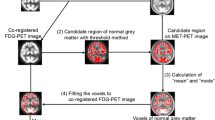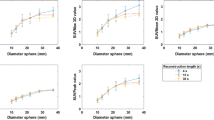Abstract
In routine clinical work, registration accuracy is assessed by visual inspection. However, the accuracy of visual assessment of registration has not been evaluated. This study establishes the limits of visual detection of misregistration in a registered brain fluorine-18 fluorodeoxyglucose positron emission tomography to magnetic resonance image volume. The “best” registered image volume was obtained by automatic registration using mutual information optimization. Translational movements by 1 mm, 2 mm, 3 mm and 4 mm, and rotational movements by 1°, 2°, 3° and 4° in the positive and negative directions in the x- (lateral), y- (anterior-posterior) and z- (axial) axes were introduced to this standard. These 48 images plus six “best” registered images were presented in random sequence to five observers for visual categorization of registration accuracy. No observer detected a definite misregistration in the “best” registered image. Evaluation for inter-observer variation using observer pairings showed a high percentage of agreement in assigned categories for both translational and rotational misregistrations. Assessment of the limits of detection of misregistration showed that a 2-mm translational misregistration was detectable by all observers in the x- and y-axes and 3-mm translational misregistration in the z-axis. With rotational misregistrations, rotation around the z-axis was detectable by all at 2° rotation whereas rotation around the y-axis was detected at 3–4°. Rotation around the x-axis was not symmetric with a positive rotation being identified at 2° whereas negative rotation was detected by all only at 4°. Therefore, visual analysis appears to be a sensitive and practical means to assess image misregistration accuracy. The awareness of the limits of visual detection of misregistration will lead to increase care when evaluating registration quality in both research and clinical settings.
Similar content being viewed by others
References
Bohm C, Greitz T, Kingsley D, Gerggren BM, Olsson L. Adjustable computerized brain atlas for transmission and emission tomography.AJNR 1983; 4: 731–733.
Maisey MN, Hawkes DJ, Lukawiecki-Vydelingum AM. Synergistic imaging.Eur J Nucl Med 1992; 19: 1002–1005.
Weber DA, Ivanovic M. Correlative image registration.Semin Nucl Med 1994; 24: 311–323.
Hemler PF, van den Elsen PA, Sumanaweera TS, Napel S, Drace J, Adler JR. A quantitative comparison of residual errors for three different multimodality registration techniques. In: Bizais Y, Barillot C, Di Paola RD, eds.Proceedings of the 14th international conference on information processing in medical imaging. Dordrecht: Information Processing in Medical Imaging; 1995: 251–262.
Bergström M, Boëthius J, Eriksson L, Greitz T, Ribbe T, Widŋ L. Head fixation device for reproducible alignment in transmission CT and positron emission tomograph.J Comput Assist Tomogr 1981; 5: 136–141.
West J, Fitzpatrick JM, Wang MY, et al. Comparison and evaluation of retrospective intermodality image registration techniques.SPIE 1996: 2710: 332–347.
Neelin P, Crossman J, Hawkes DJ, Ma Y, Evans AC. Validation of an MRI/PET landmark registration method using 3-D simulated PET images and point simulations. In: Roux C, Herman GT, Collorec R, eds.Proceedings of the satellite symposium on 3D advanced image processing in medicine in the 14th annual international conference of the IEEE. Rennes: Engineering in Medicine and Biology Society; 1992: 73–78.
Turkington RG, Jaszczak RJ, Pelizzari CA, et al. Accuracy of registration of PET, SPECT and MR images of a brain phantom.J Nucl Med 1993; 34: 1587–1594.
Studholme C, Hill DLG, Hawkes DJ. Automated three-dimensional registration of magnetic resonance and positron emission tomography brain images by multiresolution optimization of voxel similarity measures.Med Phys 1997; 24: 25–36.
Studholme C, Hill DLG, Hawkes DJ. Multiresolution voxel similarity measures for MR-PET. In: Bizais Y, Barillot C, Di Paola RD, eds.Proceedings of the 14th international conference on information processing in medical images. Dordrecht: Information Processing in Medical Imaging; 1995: 287–298.
Author information
Authors and Affiliations
Rights and permissions
About this article
Cite this article
Wong, J.C.H., Studholme, C., Hawkes, D.J. et al. Evaluation of the limits of visual detection of image misregistration in a brain fluorine-18 fluorodeoxyglucose PET MRI study. Eur J Nucl Med 24, 642–650 (1997). https://doi.org/10.1007/BF00841402
Received:
Revised:
Issue Date:
DOI: https://doi.org/10.1007/BF00841402




